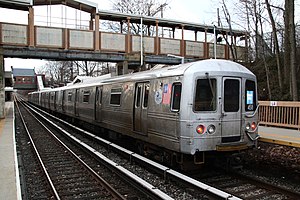This article may be too long to read and navigate comfortably. (September 2024) |


The Staten Island Railway (SIR) is the only rapid transit line in the New York City borough of Staten Island and is operated by the Staten Island Rapid Transit Operating Authority, a unit of the Metropolitan Transportation Authority. The railway was historically considered a standard railroad line, but today only the western portion of the North Shore Branch, which is disconnected from the rest of the SIR, is used by freight and is connected to the national railway system.
While the first rail proposal for rail service on Staten Island was issued in 1836, construction did not begin until 1855 after the project was attempted a second time under the name Staten Island Railroad. This attempt was successful due to the financial backing of William Vanderbilt. The line opened in 1860 and ran from Tottenville to Vanderbilt's Landing and connected with ferries to Perth Amboy, New Jersey and New York, respectively. After the Westfield ferry disaster at Whitehall Street Terminal in 1871, the railroad went into receivership and was reorganized into the Staten Island Railway Company in 1873. In the 1880s, Erastus Wiman planned a system of rail lines encircling the island using a portion of the existing rail line, and organized the Staten Island Rapid Transit Railroad in 1880, in cooperation with the Baltimore & Ohio Railroad (B&O), which wanted an entry into New York. B&O gained a majority stake in the line in 1885, and by 1890 new extensions to the line were in service. In 1890, the Arthur Kill Bridge opened, connecting the island to New Jersey. This route proved to be a major freight corridor. After a period of financial turmoil in the 1890s which saw both B&O and the Staten Island Rapid Transit Railroad company enter bankruptcy, the railroad was restructured as the Staten Island Rapid Transit Railway (SIRT), and was purchased by the B&O in 1899.
In 1924, SIRT began electrification of its lines, to comply with the Kaufman Act, which had become law the previous year. New train cars, designed to be compatible with subway service, were ordered, and electric service was inaugurated on the system's three branches in 1925. Through the 1930s and 1940s grade-crossing elimination projects were completed on the three branches. During World War II, freight traffic on the SIRT increased dramatically, briefly making it profitable. In 1948, the New York City Board of Transportation took over all of the bus lines on Staten Island, resulting in a decrease in bus fares from five cents per zone to seven cents for the whole island. Riders of the SIRT flocked to the buses, resulting in a steep drop in ridership. Service on the branches was subsequently reduced. In 1953, the SIRT discontinued service on the North Shore Branch and South Beach Branch. The South Beach Branch was abandoned shortly thereafter while the North Shore Branch continued to carry freight. While the SIRT threatened to discontinue service on the Tottenville Branch, the service was preserved as New York City stepped in to subsidize the operation. The last grade crossings on the line were eliminated in 1965. In 1971, New York City purchased the Tottenville line, and the line's operation was turned over to the Staten Island Rapid Transit Operating Authority, a division of the state-operated Metropolitan Transportation Authority (MTA). Freight service continued until 1991.
Improvements were made under MTA operations. The line received its first new train cars since the 1920s, and several stations were renovated. The MTA rebranded the Staten Island Rapid Transit as the MTA Staten Island Railway (SIR) in 1994. Fares on the line between Tompkinsville and Tottenville were eliminated in 1997 with the introduction of the MetroCard. In 2010, fare collection was reintroduced at Tompkinsville. A new station on the main line, Arthur Kill, opened in 2017, replacing the deteriorated Nassau and Atlantic stations. It was the first new station opened on the main line in seventy years. While the railway does not serve residents on the western or northern sides of the borough, light rail and bus rapid transit have been proposed for these corridors. Freight service in northwestern Staten Island was restored in the 2000s.